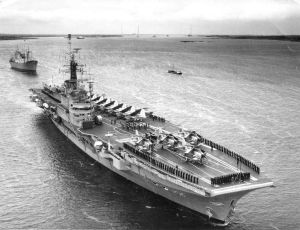
| |
| History | |
|---|---|
| Name | HMS Centaur |
| Builder | Harland and Wolff |
| Laid down | 30 May 1944 |
| Launched | 22 April 1947 |
| Commissioned | 1 September 1953 |
| Decommissioned | 1965 |
| Homeport | HMNB Portsmouth |
| Identification | Pennant number: R06 |
| Fate | Scrapped in 1972-73 |
| General characteristics | |
| Class and type | Centaur-class aircraft carrier |
| Displacement | 22,000 tons standard, 27,000 full load |
| Length | 737.75 ft (224.87 m) |
| Beam | 123 ft (37 m) |
| Draught | 27.8 ft (8.5 m) |
| Installed power | 76,000 shp (57,000 kW) |
| Propulsion | 4 Admiralty 3-drum boilers, 2 shafts, Parsons geared turbines |
| Speed | 28 kn (52 km/h) |
| Range | 7,000 nmi (13,000 km) at 18 kn (33 km/h) |
| Complement | 1,390 (including air group) |
| Sensors and processing systems | Radars, Types 960/965(AW) 982(2 sets) 983 978 293. |
| Armament |
|
| Armour | 1–2 in (25–51 mm) on flight deck |
| Aircraft carried | 42 (decreased to 26 with jet fighters). 1958-60 Sea Hawk & Sea Venom, 1961-63 Sea Vixen FAW1 & Supermarine Scimitar, 1963-65 12 Sea Vixen |
HMS Centaur was the first of the four Centaur-class light fleet carriers of the Royal Navy. She was the only ship of her class to be completed with the original design configuration of a straight axial flight deck, rather than the newly invented angled flight decks of her three later sister ships. She was laid down in 1944 in Belfast, with the contract being awarded to Harland and Wolff, but not launched until 22 April 1947 due to delays relating to the end of the war. She was commissioned on 1 September 1953, almost nine years from when she was laid down in 1944.
Centaur saw service throughout the 1950s and early 1960s. Due to budgetary issues Centaur was not converted to a commando carrier like two of her sister ships. Centaur was withdrawn from service in August 1965 and sold for scrapping in 1972.